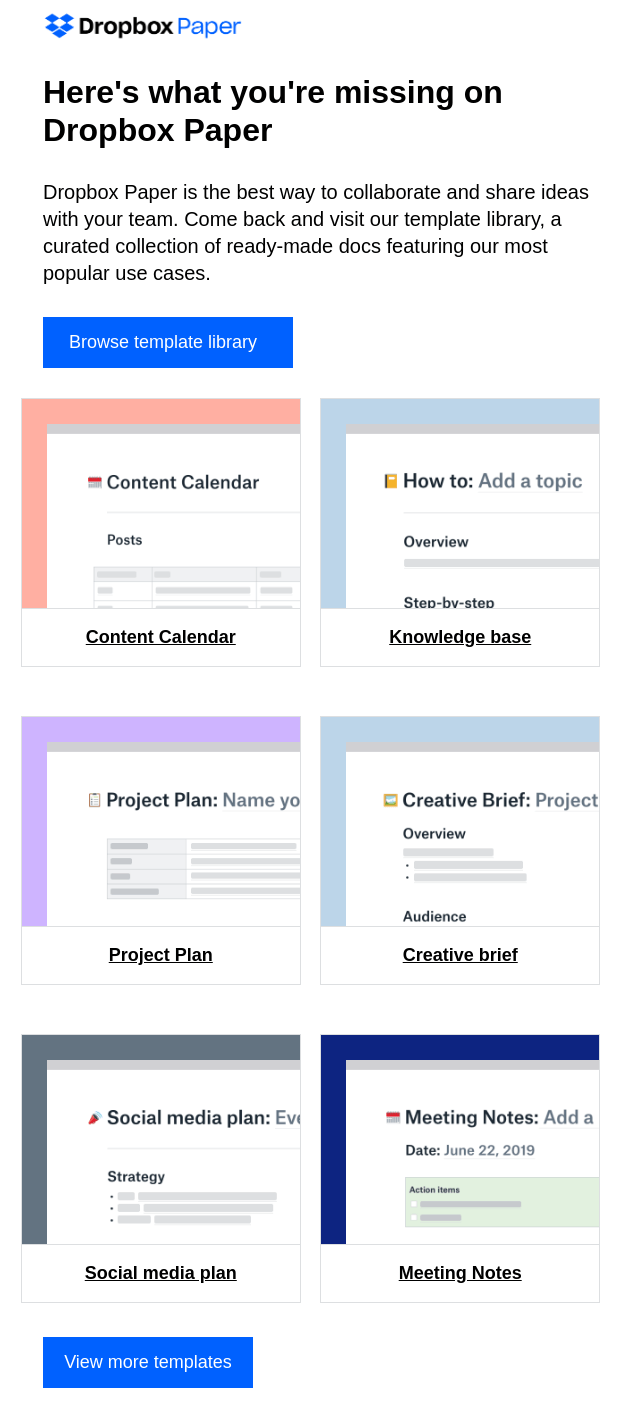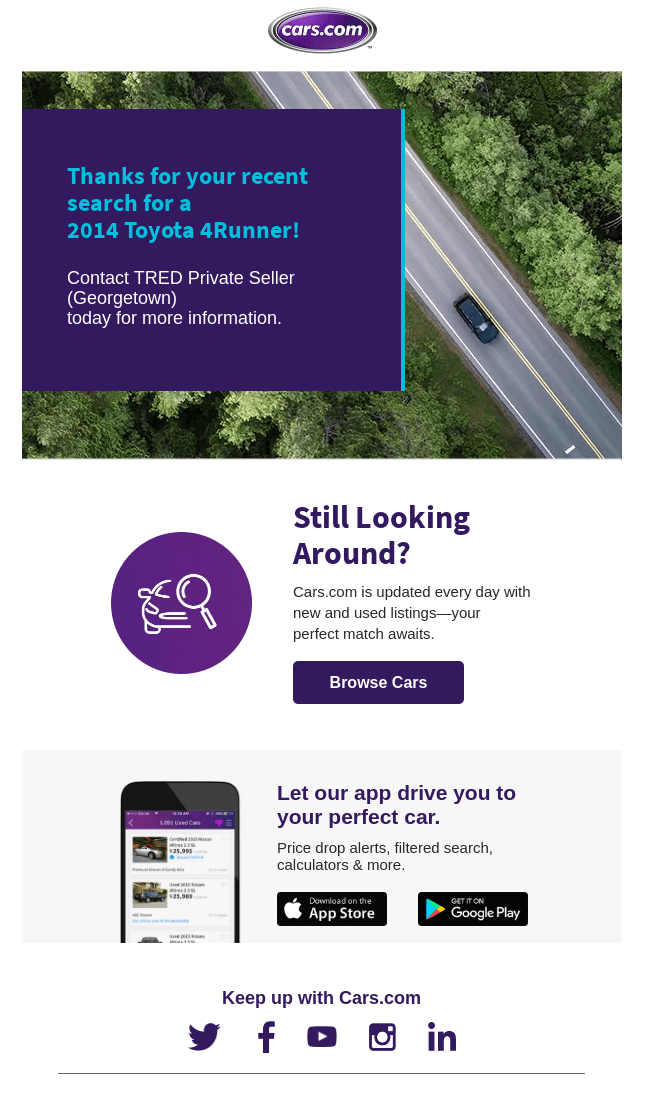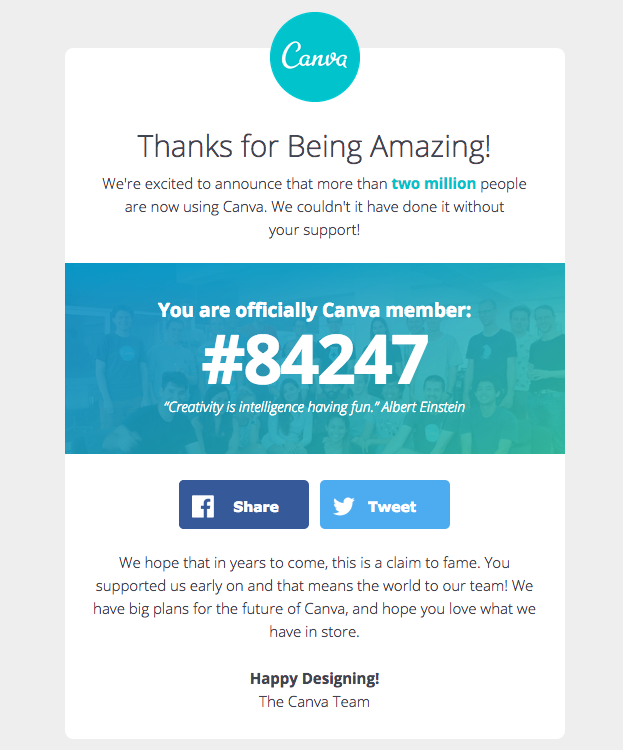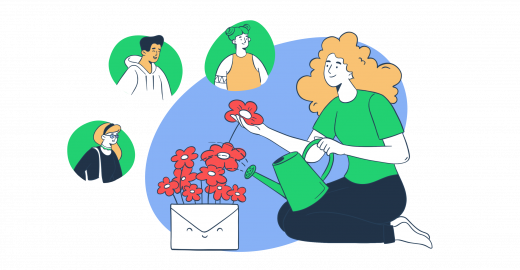To achieve high retention rates, you need to send well-written retention emails; it’s as simple as that. If you don’t know where to start, don’t worry—I’ve got you covered.
In this article, I’ll provide you with customer retention email templates you can re-use for your campaigns, and I’ll also show you:
- How to write a customer retention email [jump ahead]
- How to send customer retention emails [jump ahead]
- Established customer retention email examples [jump ahead]
At the end, I’ll also show you how to test your emails to make sure they’re pitch-perfect before you start sending them.
5 useful customer retention email templates
You’ll see below templates for 5 types of customer retention emails that work pretty much for any industry: from e-commerce to big enterprises.
Customer appreciation email
Subject line: A Unique Token of Appreciation, [Customer’s Name]
Hello [Customer's Name],
We genuinely treasure your steadfast support, and we want to express our gratitude in a distinctive way. Allow us to present you with something special to brighten your day.
You're now the proud owner of our exclusive "Gratitude Token" – a personalized gift from us to you. This unique token carries no monetary value but is filled with our appreciation for your continued support. Consider it a digital pat on the back for being an incredible part of our journey.
We eagerly anticipate the opportunity to continue delivering top-notch products and services to you, and we hope this token serves as a daily reminder of our gratitude.
Warm regards,
[Your Company]Personalized anniversary email
Subject line: Celebrate Your Anniversary with a Special Offer from Us!
Hello [Customer’s Name],
It's been a full year since you became a valued member of the [Your Company] community, and we're absolutely delighted to have you on board!
As a symbol of our gratitude for your ongoing customer loyalty, we're delighted to extend an exclusive 20% discount on your next purchase. Simply apply the discount code ANNIVERSARY20 when you check out.
Wishing you joyful shopping, and here's to many more fantastic years together!
Warm regards,
[Your Company]Product recommendation email
Subject: Exclusive Recommendations Just for You, [Customer’s Name]!
Hello [Customer’s Name],
Our observant eye caught your enthusiasm for our [product/category], and we've taken the liberty of handpicking these tailored suggestions to align with your tastes:
[Product Name 1] – A brief description of its unique features.
[Product Name 2] – Highlighting its key attributes.
[Product Name 3] – A quick overview of what makes it special.
As a special thank you, use the code MYFAVORITES10 to enjoy a generous 10% discount on your next purchase. Happy shopping!
Warmest regards,
[Your Company]Exclusive early access email
Subject line: Exclusive Offer Just for You
Hello [Customer's Name],
Your loyalty has us doing cartwheels! We've got something exciting cooking up, and we couldn't wait to share it with you. So, here's your VIP ticket to our upcoming sale – you're the star of the show!
We won't make you hunt for discount codes; we promise. Instead, imagine this: when you shop early, you'll have the first pick of our goodies, just like being the first to dive into a box of chocolates – no need to share! 😉
Now, grab your calendar and highlight [date] at [time]. That's when the fun begins, and we can't wait to have you join us for some unbeatable deals and surprises!
Warm regards,
[Your Company]Customer feedback reminder email
Subject lines: Your Thoughts Matter! Join Our Feedback Fiesta for Exclusive Perks!
Hello [Customer's Name],
Ever wondered what a genie and your feedback have in common? They both have the power to make wishes come true! Your insights are pure gold to us, and we're on a mission to make your shopping experience even better.
To thank you for your thoughts, we've conjured up a magical surprise – no, it's not a flying carpet, but it's pretty awesome! Share your feedback in our quick survey, and you'll be granted a 10% enchantment for your next order. Just click the link below to start your magical journey:
[Access the survey here]
Your opinions hold the key to our improvement spells, and we can't wait to work our magic based on your feedback. Expect even more wonders from us in the days to come!
Warmest regards,
[Your Company]How to write a customer retention email?
Your re-engagement emails can either be based on a customized template or written from scratch. Below you’ll find step-by-step instructions for both scenarios.
Customize an existing template
1. Run research and adjust your campaigns
Whether it’s customizing an existing email template or writing your own, the first step is to run research. A data-driven approach will help you easily customize and send templates that result in conversions.
Here’s what you’ll need to do:
- Research customer behavior. Are there common reasons why some customers stop engaging with your emails or website? Are there specific pain points they face? Such data can be gathered from omnichannel customer service solutions by analyzing support requests and complaints, running survey campaigns, or holding customer development sessions.
- Segment your audience: Based on the gathered data, segment your customers based on their interests, purchase history, and browsing habits. This will help you create more targeted content. Some will benefit from appreciation emails, while others need regular abandoned cart emails.
- Address the churn reasons: To tackle customer churn, create retention emails that directly address the common reasons for customers leaving. If, for example, it’s a lack of product variety, introduce new products with feature announcement emails or highlight hidden gems in your inventory. If it’s price sensitivity, show how cost-effective your product is or provide exclusive discounts. For SaaS companies, the problem could be the complexity of their products. In that case, explanatory welcome emails and thorough onboarding emails will also be part of the retention email strategy.
2. Use personalization tactics
Personalizing an existing email template for customer retention requires a thoughtful and systematic approach. Some steps you can take include:
- Personalization tokens: Incorporate personalization tokens like their first name in the email subject line and greeting. This simple touch can significantly improve open rates and engagement.
- Referencing past interactions: Mention their past interactions with your brand, like recent purchases or website visits.
- Content tailoring: Customize the email content to align with their preferences and needs. If a customer frequently buys a specific product category or subscription, highlight new items, related products, or add-ons. This is also a great chance to upsell or cross-sell your products or services.
- Behavioral triggers: Implement behavioral triggers, such as abandoned cart reminders or product recommendations based on their browsing history. These automated emails can bring back lost sales. But remember – don’t overdo it. Sending 10 emails the moment a user abandons the cart can do more harm than good.
- Testing and optimization: Continuously A/B test different elements of your personalized emails, including subject lines, content, and visuals. Analyze the data to understand what resonates most with the specific customer group.
- Maintain data accuracy: Ensure your customer data is up-to-date and accurate. By actively seeking and incorporating customer feedback solutions, you can better understand your customers’ needs and preferences. Outdated information can lead to awkward and ineffective personalization.
This way, you can create a genuinely personalized email marketing campaign that resonates with your target customer group. This can help build a strong relationship with your customers and foster loyalty.
3. Use an email marketing tool
Most email marketing tools on the market are equipped with features needed to map the customer journey and address their stages with various campaigns.
You can also use them to store your customized retention templates, schedule retention campaigns, and send emails in bulk to a specific email list. Alternatively, you could build automated campaigns that will be sent out based on pre-defined triggers.
Email marketing tools are equipped with the email infrastructure needed to ensure high deliverability rates. They help you track customer engagement with metrics such as open rates, click-through rates, conversions, bounce rates, unsubscribes, and spam complaints. These metrics can later be used to adjust and improve your retention email campaigns and relevant templates.
The following tools are among the leading options on the market:
Write your own email from scratch
Before you start executing the steps below, don’t forget the research stage we described above. You’ll need it even more when writing your own retention templates.
1. Come up with a creative subject line
Catchy email subject lines in customer retention emails are essential. They grab attention, communicate value, create a first impression, and build curiosity. Here are some tips you can use:
- Be intriguing: Create curiosity by posing a question or using a playful, unexpected statement. It should make your recipients eager to open your retention email and find out more.
- Keep it short and sweet: Short subject lines are punchier and more effective. Aim for brevity while maintaining clarity. Don’t forget to make sure your grammar is flawless – you can use Grammarly or another online grammar checker tool to check it.
- Use personalization: Include the recipient’s name or reference their previous interactions to make the email feel tailored specifically to them.
- Evoke emotion: Appeal to your readers’ emotions. Whether it’s through humor, excitement, or empathy, a subject line that stirs feelings is more likely to be opened.
- Offer value: Highlight what’s in it for the recipient. Let them know how the email will benefit them, whether it’s exclusive offers, valuable insights, or exciting news.
- Use numbers and lists: People are drawn to subject lines that promise a specific number of tips, ideas, or benefits. It makes the content seem easy to digest.
- Avoid spam triggers: Stay clear of spammy words and excessive punctuation. These can send your email straight to the spam folder.
- Be consistent with brand voice: Your subject line should reflect your brand’s personality and tone, maintaining consistency with your overall messaging.
2. Use social proof
Another great tactic is utilizing social proof in customer retention emails. It reassures current customers by showing them that others have benefited from your product or service. Some tactics you can consider include:
- Showcasing success stories: Share detailed success stories from satisfied customers who have achieved outstanding results with your product or service. Highlight the challenges they faced and how your offering made a difference.
- Leverage User-Generated Content: Encourage your customers to share their experiences with your product on social media. You can then feature these posts in your retention emails, giving them a sense of recognition and community.
- Customer Testimonials: Gather concise, compelling testimonials from your loyal customers and feature them prominently in your emails. Video testimonials can be especially impactful.
You could also use case studies, product endorsements, and social media mentions as social proof. The most important thing is to foster credibility.
3. Create FOMO
Creating FOMO (Fear of Missing Out) in customer retention emails is key. It instills a sense of urgency and exclusivity, motivating existing customers to take action and stay engaged. How can you achieve this? Here are some ideas worth considering:
- Exclusive Sneak Peeks: Provide existing customers with exclusive sneak peeks of upcoming products, services, or content. This not only makes them feel valued but also keeps them excited about what’s next.
- Countdown Timers: Incorporate countdown timers in your emails to visually emphasize the limited time available for special offers or events. This creates a heightened sense of urgency.
- Early Access: Offer early access to sales, promotions, or new releases. Make them feel like VIPs who get first dibs on your latest offerings and receive exclusive promotional emails.
4. Apply A/B testing
Just like with ready-made retention email templates, applying A/B testing is a must when writing from scratch. To get started, follow these steps:
- Define your objectives: Begin with a clear understanding of what you want to achieve through A/B testing. Which open rates are you aiming at? What retention rates do you want to reach with your email campaigns? How do you want to increase customer lifetime value? Having specific objectives will guide your testing.
- Test email elements one by one: To isolate the impact of changes, test one variable at a time. This could be the subject line, email copy, call-to-action, the design, or even the ‘unsubscribe’ button. Testing multiple elements simultaneously can make it difficult to determine what caused the change in results.
- Test all features of your emails: This includes the subject line, CTA buttons, send time and frequency, mobile optimization, various styles, tones, and lengths. This will help you create a perfect email formula for your brand and applies to all types of emails you send.
How to send customer retention email
Alright, now that we’ve nailed down the theory, let’s create a customer retention email template and launch our email campaign.
Personally, I use Mailtrap Email Marketing since it allows me to:
- Create emails from scratch or via templates
- Import and segment my contacts
- Schedule and send campaigns
Most importantly, to do all of the above, I usually don’t need more than ~15 minutes, especially if I already have an email template in mind.
Having said that, let me show you how it works!
1. Setup a Mailtrap account
Start by registering for a free Mailtrap account via your email or Google, GitHub, and Office 365 accounts.
Once you log in, you’ll have to add and verify your domain. The process is straightforward and takes around ~5 minutes.
Note: If you need additional help, feel free to check out our step-by-step Knowledge Base article or watch our video tutorial. 👀
Next, you’ll need to copy the DNS records provided by Mailtrap and add them to your email provider. Think of this as inserting a new SIM card into your phone.
You can find your DNS records (Domain Verification, DKIM, SPF, DMARC, and Domain Tracking) under the Domain Verification tab in Sending Domains. ⬇️
2. Create a customer retention email template
Now, it’s time to create our campaign draft and a customer retention email template.
Here’s what you need to do:
- Go to Email Marketing and click on ‘Create New Campaign’
- Select your domain and fill out the necessary details
- Use the drag-and-drop editor to design your template
- You can find some inspiration in the examples of well-established brands in the following section.
- P.S. Mailtrap’s very own customer retention email templates are on the way, so stay tuned!
- To test your email, click on ‘Send Test’ and it will be sent to your inbox, where you can preview how it looks in your browser or on a mobile device
- Once you’re satisfied, make sure to save the template
Note: Keep in mind that you can further test your template via Mailtrap Email Testing, which you can use to fix any rendering issues, broken links or images, and any spam words.
3. Schedule and send your email campaign
Lastly, if you haven’t already, import your email list in CSV format, select it, and then either schedule the campaign for a specified time or send it right away.
P.S. Make sure to check out the Contacts page, where you can upload, store, and organize your email addresses in different email lists for easy segmentation and targeted campaign sending.
Customer retention email examples from established brands
Let’s take a look at a couple of retention email examples to clarify even more what effective retention emails should look like.
Dropbox

Here’s what we found cool about this email:
- The email is short but informative with a clear CTA
- It has a nice set of visuals with product features
- The CTAs are placed both at the beginning and the end of the email
Something that could be improved:
- The email lacks personalization tactics
Cars.com

Some things we really liked about the example above:
- Great personalization and emphasis on something that the user has searched
- Uses a cross-selling tactic by promoting the app
- It shows a thoughtful approach, which makes it a great win-back email
The only downside is that excessive visuals and clickable options can distract the reader from the main CTA.
Canva

Canva sets a great standard for customer retention emails. Some of the interesting elements include:
- Makes the customers feel valued and appreciated without offering any financial incentives. Instead, they share how this specific user contributed to their growth, which is a great tactic to keep customers.
- The option to share the post to Twitter or Facebook not only retains customers but helps customer acquisition and boosts engagement.
- Has a very catchy heading expressing the brand’s gratitude.
What could have been improved?
- A CTA to leave feedback might come in handy here.
Wrapping up
Every email interaction with both old and new customers has an impact on their loyalty and retention. There are plenty of types of retention emails but all of them can greatly benefit your business.
Retention emails help you make important announcements (e.g., a new feature or new products), reduce cart abandonment, improve customer satisfaction, and reduce customer churn. But all of these can be achieved only if customer retention email templates are tailored to your customer retention strategy.
So, if you haven’t started already, send your first batch of retention emails – they are worth it.


